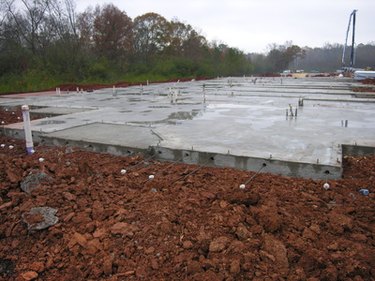
Concrete is made by mixing sand, gravel, water and portland cement. When the concrete is poured, a process called curing begins to occur. Curing consists of a chemical reaction between cement and water that must take place at an appropriate temperature. For curing to proceed properly, the concrete must be kept moist enough that the hydration process can proceed. If the concrete dries too quickly (is not cured) it will not be stable. Concrete that has been properly mixed and cured will continue to grow stronger for many years after it has been poured.
Curing Methods
Video of the Day
According to the experts at ConceteNetwork.com, there are three methods for curing concrete. Water can be added to the surface of the concrete (misting), the concrete can be sealed to prevent the already existing water from evaporating or both methods can be combined.
Video of the Day
To mist, cover the concrete with a fine mist or sprinkling of water at least twice a day for three to five days. Misting is the best method for curing concrete that has been poured indoors, but caution should be used if the concrete has been given a textured or decorative finish. Use a fine mist in light layers that will not affect the decorative finish.
For concrete that is poured outside, sealing may be the best method of curing. Moisten the concrete and cover it with building paper, burlap or roofing felt to keep the moisture in. Keep the concrete sealed for three to five days.
Concrete that is exposed to direct sunlight or hot weather should be cured by combining both misting and sealing. Uncover and mist the concrete twice a day for three to five days.
In addition, there are curing additives and admixtures, such as a product called Barrier-1, that can be mixed into the wet concrete, allowing it to cure as it dries without additional steps. However, some of these additives are cost prohibitive for the average home renovator and are more practical for contractors who do large-scale or frequent concrete work.
Other Considerations
Avoid pouring a large area of concrete on a hot day. The concrete will begin drying too quickly and won't cure properly.
Consider using a concrete sealer, a product applied as a liquid, if your concrete is going to be exposed. Sealers come in both clear and tinted varieties and can add traction to the concrete surface; however, some sealers are slippery when they get wet and should not be used outdoors.